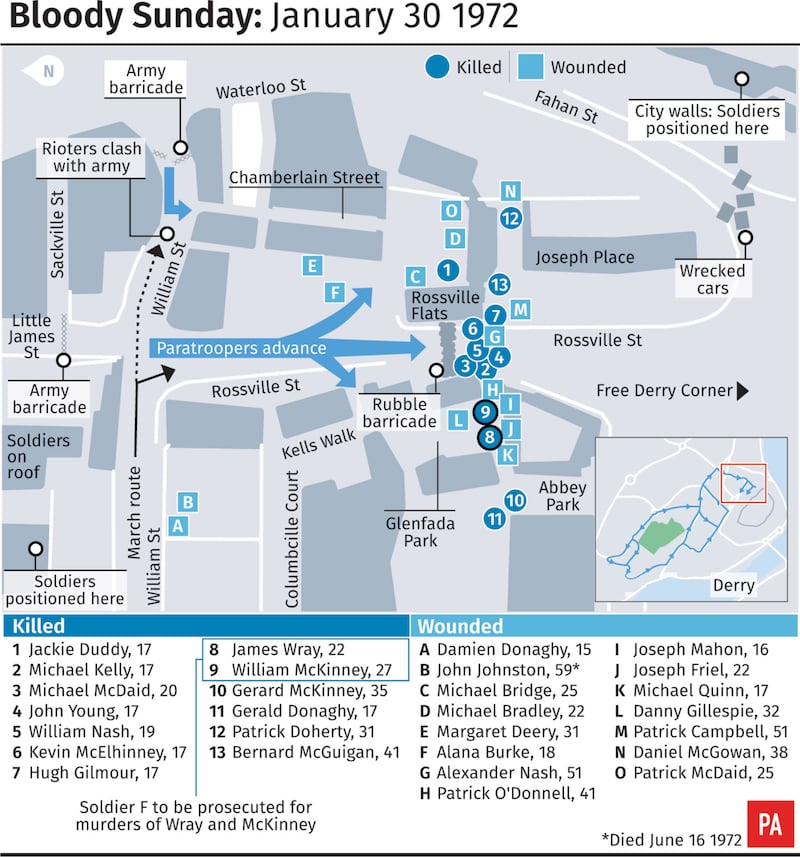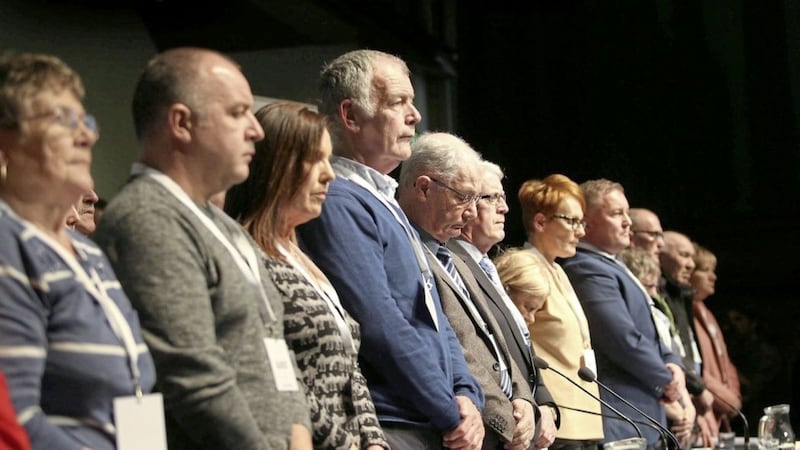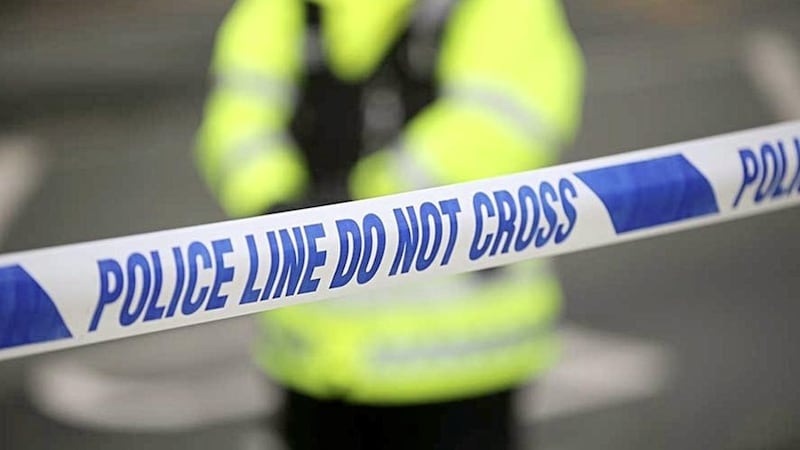THE decision to prosecute only one former soldier in connection with the events of Bloody Sunday came as a shock to the families of those who died.
However, the Public Prosecution Service (PPS) took the unusual step of releasing a detailed explanation of what test was applied when making its decision to prosecute Soldier F, while not seeking criminal prosecution against others, including two members of the Official IRA.
In total 20 people were reported to the PPS, this included 18 former members of the Parachute Regiment and the two republicans, who the Saville inquiry established were present on January 30 1972.
Five of the soldiers identified only by the cyphers, L, G,E, N and T, present in Derry when 13 people - a 14th dying later from his injuries - were shot dead during a civil rights march, are now deceased.
The test for prosecution in all criminal cases requires both the evidential and public interest test to be met. Along with the 47-year passage of time and the deaths of a number of soldiers, the Bloody Sunday case was further complicated by overarching legal issues.
Read More
- Bloody Sunday families seek review of decisions not to prosecute soldiers
- Analysis: Disappointing for Bloody Sunday relatives but they will press on
The soldiers had all given statements to the Royal Military Police in 1972. Some of the statements gave detailed and self incriminating accounts of that day. However, the PPS say that they were provided "under compulsion", no caution was administered and they were not advised that they were entitled to legal representation.
This is the moment the Director of Public Prosecutions Stephen Herron stated that one former soldier will be prosecuted for two murders and four attempted murders on Bloody Sunday pic.twitter.com/g0pcFb2dxy
— Press Association (@PA) March 14, 2019
Evidence to the Widgery Tribunal was provided by the soldiers in similar circumstances, which the PPS said made it of 'limited worth' in any criminal prosecution.
The evidence of soldiers provided to the Saville Inquiry was given following an undertaking by the Attorney General to all witnesses that it could not be used against them in any future criminal proceedings.

So while the PPS soldiers own admissions formed a central plank of Saville's findings, statements gathered in those circumstances would be almost certainly be excluded from any future criminal proceedings.
Saville divided the killings on Bloody Sunday into five 'sectors' and in giving an explanation of the prosecutorial decisions the PPS took the same approach.
Read More
- Analysis: Legacy chaos denies victims the right to normal life after loss
- Praise for Bloody Sunday families' dignity and determination
:: Sector One:
The first considerations were made concerning the injuries to Damien Donaghy and John Johnston, shot at waste ground close to William Street by soldiers from the Machine Gun Platoon who were deployed before the rest of the battalion moved into the Bogside.
Soldiers A and B were investigated for this but the test for prosecution was not found not to have been met.
:: Sector Two:
This takes in the area at the from of Rossville flats where the Mortar Platoon were deployed. Jackie Duddy was shot dead in this location and three people seriously injured. Three others were injured by flying masonry.
Soldiers N, O, Q, R, S and V were investigated for the incidents at this area. Soldier N and T, also in the area and responsible for some of the injuries caused, are both deceased.
Solider V and Q were found by Saville to have caused injuries in the Rossville flats area, but apart from their own accounts - which are inadmissible - there was no additional evidence against them.
Saville found Soldier R most likely fired the fatal shot that killed Jackie Duddy, but again apart from his own account there was no other reliable evidence and therefore the PPS concluded the test for prosecution was not met.
The PPS considered the accounts given by Soldier O in several media interviews. While bullets did not hit anyone on the day but may have indirectly caused injuries from flying masonry as all his shots hit a wall, the prosecution service concluded that there were issues with the reliability of his accounts.
They also excluded any possibility of successfully prosecuting Soldier S for injuries caused in the Rossville flats area.
Read More
- Bloody Sunday prosecution: Who is Soldier F?
- Bloody Sunday families: 'I could cry but I'm not going to cry'
::Sector Three:
This includes those killed or injured in Rossville Street. Michael Kelly, Hugh Gilmour, John Young and Kevin McElhinney were all killed in this location. Alexander Nash was injured in the area.
Soldiers F, J, K, M, P, U and Soldier 039 were all in this location. Saville linked Soldier U to the death of Mr Gilmour. However again once his own account was disregarded as there was no other available evidence.
Soldier F was linked to Michael Kelly's death. The PPS said the examination of a bullet taken from the teenager's body could be connected a rifle soldier F admitted to firing that day, but it relied on his admissions which could not be used in court.
Soldier P, J and E were linked to the shooting in the vicinity where William Nash, John Young and Michael McDaid were shot. Soldier E has since died.
The PPS ruled that once their own statements were disregarded there was no reasonable chance of prosecution of either P or J.
Saville linked either Soldier L or M to the killing of Kevin McElhinney. Soldier K also fired in this vicinity.
Soldier L is deceased and there was no evidence against K other than his own statements. Apart from his own inadmissible account the only other evidence against M was deemed hearsay.
Soldier 039 was believed to have encouraged the other soldiers to open fire. The PPS said the test for prosecution was not met in relation to this accusation.
Soldiers C, D,F - along with G and L who are deceased - are known to have fired at a window of Rossville flats where a photographer had positioned himself. The PPS said as they claimed they believed themselves to be shooting at a gunman there was a strong self defence argument for those shots.
Read More
- Bloody Sunday: Attorney General asked to investigate Gavin Williamson's remarks
- Public Prosecution Service spells out in detail Blood Sunday decisions
::Sector Four
James Wray and William McKinney were shot dead in 'Sector Four'. Joseph Friel, Michael Quinn, Joe Mahon and Patrick O'Donnell were all injured at Glenfada park.
Soldiers F and H were present in this area as were Soldiers G and E who have both since died. In respect of Soldier H there was no admissable evidence.
Soldier F will however face prosecution for the two murders and four attempted murders after the PPS ruled there was sufficient evidence against him.
::Sector Five
This is concerned with the events at the rear of the Rossville Flats.
The PPS condcluded that the test for prosecution was not met and a decision taken not to prosecute Soldier F in respect of any sector 5 casualty.
::Official IRA
Two members of the Official IRA both admitted to firing shots on Bloody Sunday, neither of which hit any target on the day. Both made admissions to Saville which were inadmissible and no eye witnesses were available.








